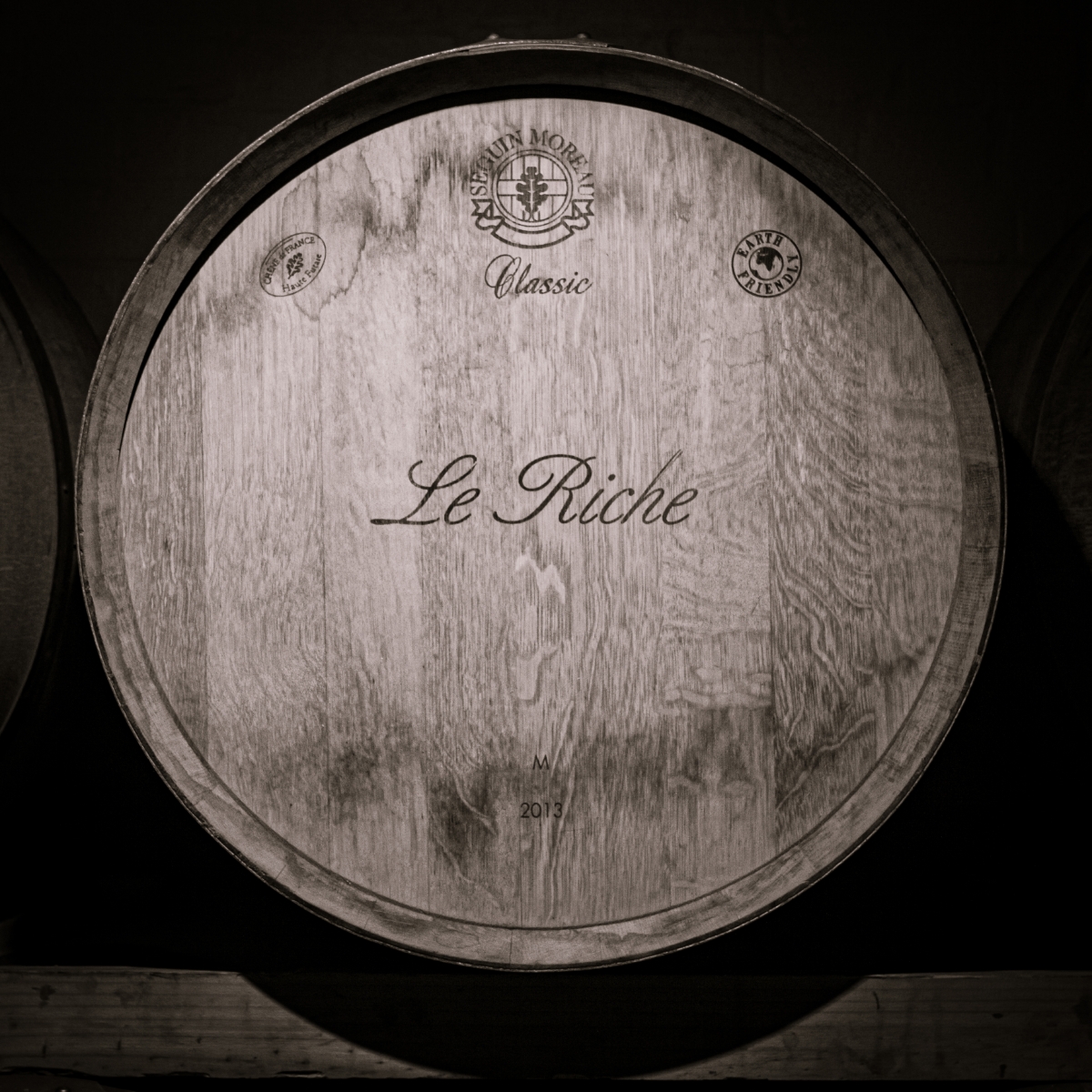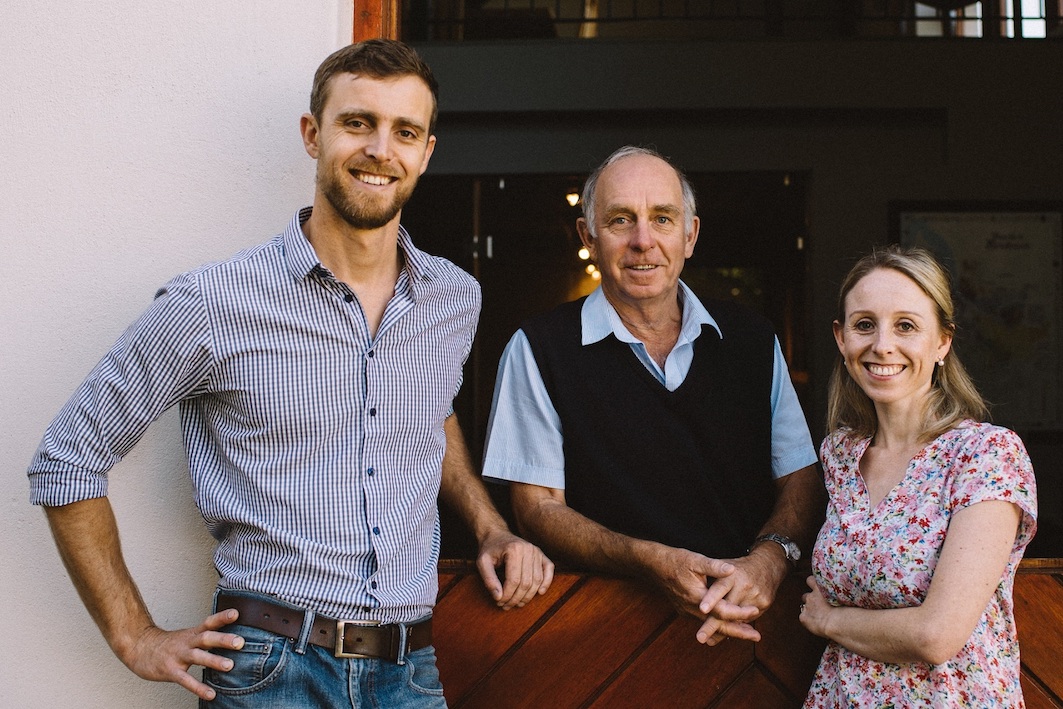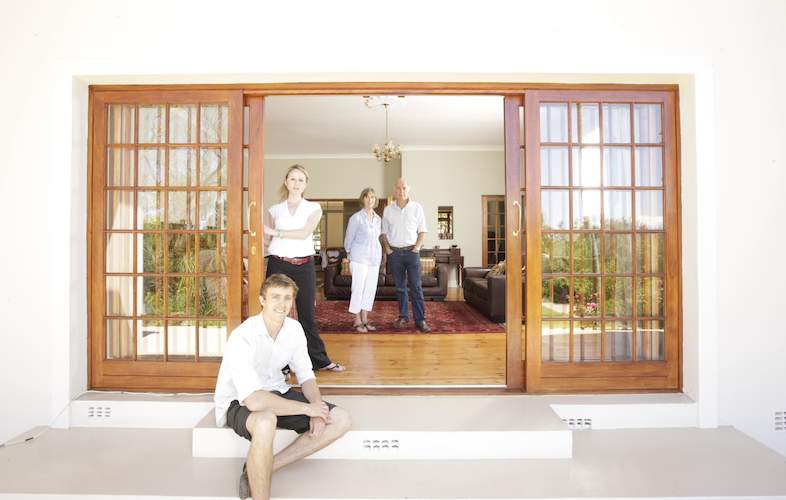SA Wine Legend: Etienne le Riche
“This farm used to be called Zeezicht,” says Etienne le Riche gesturing to the view of the blue sea over the hills of rolling vines. Because of this ocean proximity the Helderberg is one of the cooler wards in Stellenbosch. We can feel the faint stir of the breeze coming off it, from our vantage point at Le Riche Wines, a name synonymous with premium cabernet sauvignon.
Walking over to his house, which is adjacent to the cellar, Etienne shows me young cabernet vines they’ve planted. A first as they have sourced fruit from vineyards around Stellenbosch since inception of the brand rather than growing their own. We get to his home, which overlooks a fragrant garden bursting with roses and the hum of bees.
Though only now into the second generation of winemaking, long has the Le Riche name been uttered in the corridors of this country. Records describe how Lodewyk le Riche and his family left Normandy for South Africa as far back as 1698. With forebears helping establish what would become the Kgalagadi National Park.
Growing up in Cape Town to a family of lawyers, wine was introduced at dinner from early on. “When it came time to study I was confused about what I wanted to do,” Etienne recalls. His first year at Stellenbosch University saw him studying medicine. His heart wasn’t in it. With the goal of remaining in the Cape, he went on to study agriculture and obtained a B.Sc. in viticulture and oenology in 1971. He followed this with two years at the Nietvoorbij Oenological and Viticultural Research Institute.
Since the get-go Etienne has been pivotal in the story of Cape Cabernet. During his time at the institute the certification system came into effect.
Today he’s readied a line up of wines to illustrate his cabernet journey. “This was the first cabernet to be certified in South Africa,” he says holding up a 1971 Rustenberg that he had bottled.
His relationship with the historic Rustenberg estate strengthened. A couple of years later the job of assistant winemaker was his. He was under the tutelage of Reg Nicholson, who famously created the estate’s ‘Dry Red’ (cab juiced up with cinsault). “Reg had been on the farm for a number of decades by then and wanted to retire, so it was a relatively short crash course of two years before becoming winemaker. The focus was always on cab.”
He stayed for 20-years. “It was a privilege to live and work on the farm, my children were born there.” During this time he was instrumental in helping the Barlow family achieve status as a Cape ‘First Growth’ and references the 1982 Rustenberg Cabernet as one of the highlights. The wine was awarded an International Wine & Spirit Competition (IWSC) Gold medal. “That was one of the greatest vintages South Africa had seen up until that point. People still talk about that wine.
“It was also the period where we started introducing new oak into our winemaking. That also played a big role in its success as using new oak was a relatively unheard of thing at the time.” They started importing bigger oak vats, new oak barrels and smaller casks from 1980 onwards. “That brought a new dimension to the wines.”

In his early days at the historic Stellenbosch farm he asked proprietor Peter Barlow if he could travel to gain insight into the Old World. And so, with friend Vaughan Johnson (the well known wine shop owner and author) he went abroad. “For three months we travelled all over the European wine regions, staying in a little camper van.” They travelled through Bordeaux, Burgundy, the Rhône, Champagne, the Rhine, and Rioja. They landed back home in 1977, arriving to snow on Table Mountain. “It was the coldest, wettest vintage I've ever experienced in the Cape.”
In 1981 he earned an M.Sc. in viticulture, before embarking on another wine tour in 1983. Concentrating his time in cab Mecca, Bordeaux, followed by stints in California and Washington State.
During his two decades at Rustenberg he also became friends with the legendary Billy Hofmeyr. Along with sharing a passion for French wine, the two were part of the cohort of founding members of the Cape Winemakers Guild in 1982.
“We drank a lot of French wines and analysed them. We started making wines more in that fashion: with lower alcohols, adjusting sugars and introducing malolactic conversion,” elaborates Etienne. “All those technologies were new then. We were the rebels of the industry,” he laughs.
In 1996 he left Rustenberg to start his own eponymous brand, Le Riche Wines. “That’s the farm in the Jonkershoek we first moved into,” he says pointing at a painting hung on his lounge wall.
From the wines in front of us he pulls forward a bottle with the farm’s name on the label: ‘Leef Op Hoop’ (2000). “I thought ‘live in hope’ was a rather apt name for this stage of the journey,” he says smiling. Certainly it was a brave move going on his own, and no less in the premium red wine sector, a category generally left to generationally owned estates. He says simply: “I knew what to do when the moment arrived.”
To keep liquid in the beginning stages he bought in wine immediately for the first release in 1996. Following that he sourced grapes for the first Le Riche wine, the 1997 vintage. The wine achieved 5-stars in Platters Wine Guide as well as a Veritas Double Gold. “That was huge, the success lifted me to where I wanted to be.” This initial boost honed the focus on cabernet for the brand as well as instilling the business model of sourcing high quality fruit. Etienne has been buying grapes from one of the growers since 1999.
The family spent 15 years at Leef Op Hoop. A few other wines stand out from this time. There was the Le Riche Bergerac Grand Vin de Terroir 2002, a wine he made in Bergerac near Bordeaux, which he sold in South Africa.
Then also the 1999 vintage of both the Cabernet and the Cabernet Reserve. When the wines were sent into Platter’s Wine Guide, it was the Cabernet and not the Reserve, which was awarded the coveted five-stars. Smartly, Etienne simply swapped the labels around; the Reserve was now in the Cabernet bottle and vice versa.
They secured the Helderberg property in 2010, officially moving in in 2013. By this time his son Christo was at his side, slowly taking over winemaking duties.
Currently the brand produces 60 000 bottles per year, 80 per cent of which is premium cabernet. Looking to the future Etienne says: “We must concentrate on what we've built. And, yes we want to grow, but with provenance.” The way the winery is set up with open tops positioned directly on top of tanks means they have good traceability and can keep sites separate.
“We’ll continue to focus on Stellenbosch cabernet and see how much we can grow.”
Le Riche Wines is still very much a family concern. Christo is the Director and Cellarmaster (assisted by winemaker Mark Daniels), daughter Yvonne commands exports and logistics, while nephew Francois le Riche is the commercial manager.

At 74 Etienne is now retired, though he still acts in an advisory role. He spends time with his ballet-instructor wife Marcelle. They love the arts, nature and, of course, sharing a good bottle of wine.

- Blog by Malu Lambert